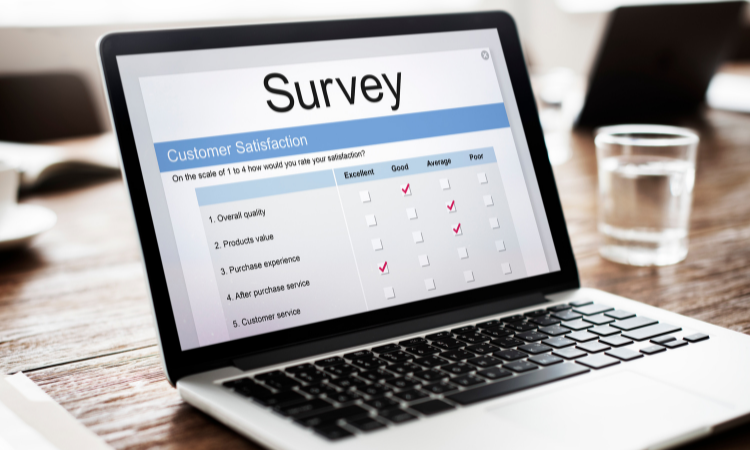Surveys—once a tedious task of pen and paper—have rapidly evolved into dynamic online tools that are indispensable in today's digital era. Over the past few years, there has been a remarkable surge in the use of online surveys, with more than 80% of businesses now relying on them to gather feedback and drive data-informed decisions. This isn't just a fleeting trend; it's a fundamental shift in how we understand and engage with our audiences.
Why are online surveys making such a significant impact? The answer lies in their simplicity and effectiveness. They offer a quick and efficient way to collect relevant data from users and customers, providing a deeper, more comprehensive understanding of their needs and preferences. The convenience doesn't stop there—online surveys are incredibly cost-effective and have an unparalleled reach, allowing us to connect with a global audience right from our desktops, laptops, or mobile devices.
In this blog, we'll dig deep to understand all about online surveys, —exploring why they're essential, how they differ from traditional methods, and the best practices for creating surveys that yield actionable results. By the end of this blog, you'll be equipped with the knowledge and tools to harness the full potential of online surveys, driving informed decisions and fostering meaningful connections with your audience. So, let's dive in!
TL; DR
- Online surveys are a powerful way to collect feedback, drive data-driven decisions, and foster better customer relationships. They are versatile and can be used in various situations, including market research, collecting customer feedback, measuring customer satisfaction, and more.
- Online surveys outperform traditional methods by eliminating geographical and cost barriers, offering real-time data collection, and enabling personalized feedback experiences.
- Best practices for conducting online surveys include keeping surveys concise, using diverse question types, avoiding biases, and ensuring data privacy to improve response rates and data quality.
- Zonka Feedback is a robust online survey platform offering features like advanced customization, real-time analytics, and multi-channel distribution, making it ideal for businesses to gather actionable insights.
- With tools like Zonka Feedback, managing your survey online is easy, from customization to data analysis. You can sign up for a free 14-day trial to explore the extensive features of this platform.
Gather Valuable Customer Insights with Online Surveys ⭐
Engage your customers on any device with powerful online surveys, collect actionable feedback, and make data-driven decisions to deliver exceptional experiences.

What is an Online Survey?
An online survey is a modern, efficient way to collect feedback and data from your target audience using the internet. Think of it as a digital questionnaire that can reach participants anywhere, anytime—through email, SMS, websites, mobile apps, or even social media. Whether you’re gauging customer satisfaction, exploring product preferences, or conducting market research, online surveys offer a versatile and user-friendly solution.
Why Do We Need Online Surveys?
As the world increasingly shifts toward digital platforms—be it shopping from local stores online, engaging in virtual consultations, or conducting market research—relying on offline survey methods is becoming less practical. Sticking to traditional surveys not only limits the reach and scope of your research but also makes data collection and analysis more challenging. For market research companies, a streamlined survey building process helps uncover trends and consumer insights, ensuring informed decision-making.
In today's fast-paced, digitally connected environment, the ways we gather data and feedback must evolve to keep pace. Traditional methods like paper questionnaires and telephone interviews no longer meet the demands of modern research and business needs. That's why online surveys have become a necessity for:
1. Overcoming Limitations of Traditional Methods
-
Geographical Barriers: Traditional surveys are often limited by location and accessibility. Online surveys eliminate these barriers, allowing you to reach a global audience effortlessly.
-
Time Constraints: Collecting and processing data through traditional means is time-consuming. Online surveys provide real-time data collection and instant access to responses.
-
Higher Costs: Printing, mailing, and manual data entry associated with paper surveys increase costs. Online surveys reduce or eliminate these expenses.
2. The Need for Real-Time Insights
-
Immediate Decision-Making: In a competitive market, businesses need to make quick, informed decisions. Online surveys offer immediate feedback, enabling swift action.
-
Dynamic Market Conditions: Consumer preferences change rapidly. Online surveys help businesses stay updated with the latest trends and adapt accordingly.
3. Changing Communication Preferences
-
Digital Engagement: As more people engage online, reaching them through digital channels is more effective. Online surveys meet audiences where they are most active.
-
Convenience: Respondents prefer the flexibility to complete surveys at their convenience. Online surveys accommodate busy schedules and increase participation rates.
4. Customization and Personalization
-
Tailored Experiences: Online surveys allow for personalized questions and adaptive pathways based on respondent answers, improving relevance and engagement.
-
Brand Consistency: They enable organizations to maintain brand identity through customized designs and messaging.
By addressing these challenges and meeting modern needs, online surveys have become indispensable for effective data collection and engagement.
A Quick Comparison Between Online & Offline Surveys
When choosing between online and offline surveys, it’s essential to understand how they differ in functionality, reach, and application. Each method has unique strengths tailored to specific needs and environments, making them suitable for varied scenarios.
| Aspect | Online Surveys | Offline Surveys |
|
Platform |
Accessible via websites, emails, social media, apps, etc. |
Uses apps or software on touchscreen devices like tablets and smartphones. |
|
Distribution |
Delivered through digital channels like email, SMS, or social media. |
Conducted in-person via kiosks, tablets, or other devices. |
|
Internet Dependency |
Requires an active internet connection for distribution and completion. |
Can be conducted without any internet connection. |
|
Data Storage |
Data is stored directly in the cloud or online platforms. |
Data is stored locally on the device and synced when online. |
|
Real-Time Feedback |
Responses are instantly accessible for analysis. |
Feedback is stored offline and synced later for access. |
|
Best Suited For |
Wide-scale surveys targeting geographically diverse audiences. |
Field research, events, or locations with no internet access. |
|
Customization |
Highly customizable with multimedia options like images and videos. |
Limited to the features available in the offline app. |
|
Reach |
Global reach with no geographical constraints. |
Limited to the physical location where the survey is conducted. |
|
Response Handling |
Data is processed automatically and in real-time. |
Responses are processed once synced to the server. |
|
Cost Implications |
Cost-effective for broad distribution without physical setup. |
Costs may include device setup and offline app licensing. |
|
Examples |
Website surveys, email surveys, and social media polls. |
Kiosk surveys, field surveys using tablets or smartphones. |
How Do Online Surveys Work?
At their core, online surveys involve a series of questions that participants can answer at their convenience using various devices like computers, tablets, or smartphones. Here's a simple breakdown of the process:
-
Designing the Survey: You start by crafting questions that align with your objectives. These questions can be in different formats, such as multiple-choice, rating scales, open-ended responses, or even interactive elements like sliders and drag-and-drop rankings.
-
Distributing the Survey: Once your survey is ready, it's time to share it with your target audience. This can be done through:
- Email Invitations: Send direct links to participants via email.
- Website Embedding: Place the survey on your website or as a pop-up.
- Social Media: Sharing the survey link on platforms like Facebook, Twitter, or LinkedIn.
- Mobile Apps: Integrating the survey within an app for users to access seamlessly.
- Collecting Responses: Participants fill out the survey at their own pace. Their responses are automatically recorded and stored securely, ensuring data integrity.
- Analyzing the Data: With built-in analytics tools provided by survey platforms like Zonka Feedback, you can quickly visualize results, identify trends, and extract meaningful insights charts and sentiment analysis.
Types of Online Surveys and Their Effective Usage: Distribution Channels
Online surveys come in various forms, each tailored to specific channels, audiences, and goals. Selecting the right type depends on your purpose and where your audience is most active. Here's a detailed look at different types of online surveys based on their distribution channels. Learn how they work, and when to use them effectively.
1. Email Surveys
Email surveys are one of the most popular and effective methods of collecting feedback. They can reach respondents across devices, ensuring excellent delivery rates and engagement. Email surveys are versatile and can include advanced features like embedded questions or in-signature surveys.
Features
-
In-Signature Surveys: Include survey questions in email signatures to passively collect feedback during routine communications.
-
Embedded Surveys: Place questions directly in the email body to make it easier for respondents to participate without additional clicks.
-
Automated Distribution: Send bulk surveys using CSV uploads, automated workflows, or integrations with third-party tools.
When to Use
-
Post-transaction or post-service feedback.
-
Satisfaction surveys like NPS, CSAT, or CES.
-
Employee engagement or internal feedback.
Advantages
-
Can target a wide and diverse audience.
-
Customizable templates improve brand alignment.
-
Easy to track open rates, click-throughs, and responses.
Best Practices
-
Keep surveys concise to respect recipients’ time.
-
Personalize subject lines and content to increase open rates.
-
Optimize for mobile to ensure accessibility.
2. Website Feedback Surveys
Website surveys collect feedback directly from visitors while they interact with a website or digital product. These surveys can be embedded on web pages, triggered as pop-ups, or integrated as feedback widgets.
Features
-
Pop-Over Surveys: Appear dynamically based on user behavior, such as after spending time on a page or completing a transaction.
-
Button Widgets: Small buttons placed on a website’s edge or corners, allowing visitors to provide feedback whenever they choose.
-
Embedded Surveys: Inline feedback forms seamlessly integrated into pages or blogs to gather insights.
When to Use
-
To understand user behavior and satisfaction with website usability.
-
After specific interactions like completing a purchase or using a feature.
-
To collect opinions on website design or content effectiveness.
Advantages
-
Real-time feedback provides immediate insights.
-
Flexible design options for minimal intrusion.
-
Useful for tracking customer journeys and identifying pain points.
Best Practices
-
Use pop-overs sparingly to avoid annoying visitors.
-
Position widgets where users are most likely to engage.
-
Combine feedback data with website analytics for deeper insights.
3. In-App Surveys
In-app surveys are integrated directly into mobile or web applications, enabling businesses to collect feedback from active users. These surveys are triggered contextually, ensuring relevance and high response rates.
Features
-
Contextual Triggers: Display surveys based on user actions, such as completing a purchase or finishing a game level.
-
Customizable Design: Match the survey interface with the app's branding for a seamless experience.
-
Real-Time Feedback: Collect impressions while the user is still engaged.
When to Use
-
To evaluate app usability and functionality.
-
After introducing new features or updates.
-
For troubleshooting issues or understanding user needs.
Advantages
-
High engagement as surveys target active users.
-
Provides immediate insights for continuous improvement.
-
Non-intrusive designs ensure minimal disruption to user flow.
Best Practices
-
Limit the number of questions to maintain user engagement.
-
Trigger surveys only after meaningful user interactions.
-
Act on feedback quickly to show responsiveness.
4. SMS Surveys
SMS surveys are distributed via text messages, offering a quick and convenient way to gather feedback. They are highly effective in regions or scenarios where internet access may be limited.
Features
-
Short and Direct: Questions are concise and formatted for easy completion via text.
-
Survey Links: Include short links to direct recipients to detailed surveys online.
-
Scheduled Messaging: Deliver surveys at specific times for optimal engagement.
When to Use
-
After transactions, deliveries, or customer service interactions.
-
To collect feedback at offline events or in-store visits.
-
For quick sentiment checks or simple queries.
Advantages
-
High open rates compared to email surveys.
-
Easily accessible on any mobile device.
-
Does not require internet connectivity to respond.
Best Practices
-
Use clear, conversational language in messages.
-
Limit the survey to one or two questions for quick responses.
-
Time messages appropriately to avoid disturbing recipients.
5. WhatsApp Surveys
WhatsApp surveys leverage the familiarity and popularity of messaging apps to collect feedback. These surveys are conversational and personalized, ensuring high engagement rates.
Features
-
Interactive Elements: Use buttons, quick replies, and rich media for engaging surveys.
-
Automated Distribution: Integrate with APIs to send surveys after key customer interactions.
-
Multilingual Support: Collect feedback in the respondent’s preferred language.
When to Use
-
To gather feedback immediately after a customer support interaction.
-
To conduct personalized outreach campaigns.
Advantages
-
High engagement due to WhatsApp’s popularity.
-
Allows for multimedia-based questions and responses.
-
Facilitates real-time feedback collection.
Best Practices
-
Personalize surveys to enhance the respondent’s experience.
-
Keep questions brief and to the point.
-
Use automation to follow up with non-respondents effectively.
6. QR Codes and Survey Links
QR codes and survey links offer a versatile way to share surveys across digital and physical channels. They are quick to distribute and can be placed on various mediums to collect feedback instantly.
Features
-
QR Codes: Easily scannable barcodes that link directly to surveys, ideal for print materials.
-
Versatile Links: Shareable links that can be included in social media posts, emails, or websites.
-
Customizable Design: Tailor QR codes and links to match branding.
When to Use
-
At events or physical locations (e.g., stores, restaurants).
-
On receipts, posters, or product packaging.
-
For offline campaigns seeking to transition users to online platforms.
Advantages
-
Quick and user-friendly, requiring no app installation.
-
Suitable for both online and offline scenarios.
-
Provides instant access to feedback forms.
Best Practices
-
Place QR codes in visible, high-traffic areas.
-
Use short, branded URLs for easy recall.
-
Monitor scan rates and clicks to optimize distribution strategies.
Each type of online survey serves specific purposes and excels in particular scenarios. By aligning the survey type with your goals and audience behavior, you can maximize response rates, enrich insights, and improve decision-making processes.
Benefits of Using Online Surveys
-
Faster Reach to Target Audience: Online surveys are an incredibly swift method to gather feedback. Unlike traditional techniques, surveys online can be instantly distributed via email, social media, or websites, enabling organizations to connect with respondents in real-time.
-
Real-Time Analysis: With advanced online survey tools, researchers can analyze data as responses come in. Features like centralized dashboards allow you to track opinions, user responses, or Net Promoter Scores (NPS) in real-time, empowering quick and informed decision-making.
-
Cost-Effective Solution: Conducting surveys online eliminates costs associated with printing, mailing, or phone calls. Additionally, free online survey platforms further reduce expenses, making it an economical way to collect feedback without compromising on quality.
-
Minimal Margin of Error: Since respondents directly submit their answers, the risk of errors caused by intermediaries or manual data entry is significantly reduced. This ensures highly accurate data collection.
-
Convenient for Respondents: An online survey is designed to be user-friendly and easily accessible. Respondents can answer surveys online with just a click, whether via email, website, or social media, enhancing participation rates.
-
Time-Saving for Researchers: From creating an online survey to analyzing results, the entire process is automated and efficient, allowing researchers to focus on strategic tasks instead of administrative work.
-
Global Reach and Scalability: Whether targeting a niche demographic or a global audience, surveys online offer unparalleled scalability. They are ideal for organizations seeking to gather feedback from thousands of respondents quickly.
-
Customizable and Interactive: Online survey platforms often allow customization, enabling businesses to incorporate branding, conditional logic, and multimedia elements like videos and images. This enhances engagement and provides a professional touch.
-
Advanced Targeting Capabilities: Online surveys can be precisely targeted to specific demographics or customer segments, ensuring the feedback collected is actionable and relevant.
-
Monitoring and Follow-Up: With surveys online, researchers can track completion rates and send automated reminders to non-respondents, improving participation without manual intervention.
By leveraging the power of online surveys, organizations can efficiently collect actionable insights, save resources, and engage audiences in a modern, user-friendly way. Whether using a free online survey tool or a paid platform, the benefits are undeniable.
How to Create an Online Survey With Zonka Feedback (Step-by-Step)
Zonka Feedback simplifies the process of creating and managing online surveys with its intuitive platform and customizable features. Here’s a step-by-step process to create surveys from ideation to analytics:
Step 1 Define Your Survey Goals
-
Decide the Purpose: Clearly outline why you are conducting the survey (e.g., to measure customer satisfaction, product feedback, net promoter score, or employee engagement).
-
Set Objectives: Define the insights or outcomes you wish to achieve, such as understanding user behavior, gathering feedback on a product, or improving customer service.
-
Choose the Survey Type: Decide how to conduct your online survey based on your goals. Use website surveys for real-time visitor feedback, email surveys for metrics like CSAT, CES, and NPS, or other types like SMS, WhatsApp, or in-app surveys to suit your needs. Zonka Feedback offers options tailored to various purposes.
-1.png?width=2022&height=1258&name=frame_generic_light%20(8)-1.png)
Step 2 Adding a New Survey
After creating your account in Zonka Feedback, you can effortlessly create your first free online survey. After signing up, you will be directed to the home screen of the platform, where you can create a new online survey. There are two options to add a new survey:
-
Click on the “Add Survey” button at the middle right of the screen, or you can also click on the (+) icon in the left panel and select “Add Survey”.
-
Now, a new screen will appear, where you can create a survey using pre-designed customizable templates, generate one with AI, or create a new survey manually from scratch if you already have your set of questions.
-
Zonka Feedback provides you the pre-designed templates for various use cases you can choose any of the survey templates based on your requirements. Suppose you want to measure your CSAT score then you can choose the CSAT survey template from the template section.


Step 3 Choose Distribution Channel
Now after selecting the CSAT survey, it's time to choose how you want to send your online survey. You can choose any of the distribution channels available. With Zonka Feedback you can send your online surveys via different distribution channels. Here, let's select "Email" as a distribution channel. After selecting email you will have three options of sending via email.
-
You can send the online survey directly from the Zonka Feedback platform.
-
You can embed the survey in email body or the email signature section.
-
You can also distribute the online surveys via your CRM tools after integrating with the Zonka Feedback.
-png-1.png?width=2022&height=1258&name=frame_generic_light%20(9)-png-1.png)
Step 4. Customize Your Survey
Customization allows you to align surveys with your brand identity and tailor them to your audience's needs. You can customize the welcome screen, exit screen, questions, colors, fonts, logos, etc. Read more about how you can customize your surveys below:
-
Survey Questions: Modify and organize questions to match your survey goals. Add, remove, or rephrase questions to ensure they are relevant and clear for your recipients.
-
Branding and Design: Customize the colors, fonts, and layout of the survey to reflect your brand. A consistent design builds trust and strengthens your brand identity.
-
Multilingual Options: Offer your survey in multiple languages if your audience is diverse. Allowing respondents to answer in their preferred language ensures better clarity and richer feedback.
By customizing your online survey, you can create a seamless experience that resonates with your audience, encourages participation, and delivers meaningful insights.

Step 5: Preview and Send Your Survey
After creating your online survey, preview it carefully to check for errors. For email surveys, you can choose to send the survey immediately, schedule it for later, or automate it based on specific customer actions like purchases. For website surveys, you can copy the code of the survey and paste it into your website. For an SMS survey, you can add contact details to send your survey to the person you want to share.
Best Tools to Conduct Online Surveys
Online survey software helps businesses gather valuable insights and feedback efficiently. Here’s a look at five of the best tools, each offering unique features to suit various needs and use cases:
Zonka Feedback
An AI-powered survey platform offering multiple question types, advanced logic, multilingual options, and real-time analytics like sentiment analysis. It supports multi-channel distribution via email, SMS, website widgets, WhatsApp and microsurveys, ensuring versatile feedback collection.
With seamless integrations into tools like Salesforce and Slack, Zonka Feedback simplifies automation, enabling businesses to gather and act on insights efficiently. It also offers a free version which allows you to create unlimited surveys and send them to your customers.

SurveyMonkey
A widely-used survey tool known for its user-friendly design and multiple question types, including NPS and rating scales. While its free plan is limited, premium versions unlock advanced features like logic, branding, and integrations with platforms like Salesforce and HubSpot. It’s ideal for individuals and organizations looking for scalable and intuitive feedback solutions.

Qualtrics
A powerful enterprise survey maker offering extensive customization, advanced logic, and AI-driven insights. With over 100 question types, robust analytics, and seamless integrations with systems like Salesforce, Qualtrics excels in managing large-scale surveys across multiple channels. It’s perfect for optimizing customer and employee experiences.

Survicate
An online survey app designed for product surveys, capturing feedback at critical moments via websites, apps, or email. With dynamic logic, AI-driven analysis, and integration with tools like HubSpot and Salesforce, it delivers real-time insights to improve customer experience. Survicate’s strategic targeting makes it ideal for actionable, on-the-spot feedback.

Typeform
A survey app popularly used for creating engaging, conversational formats and sleek designs. Features like conditional logic, personalized questions, and interactive layouts make it stand out. Integrated with tools like Google Sheets and Zapier, Typeform is perfect for businesses seeking creative and user-friendly surveys to connect with their audience.

Google Forms
Google Forms is a free survey tool ideal for creating free online surveys with ease. It lets users design their own surveys with unlimited survey questions, customizable templates, and seamless Google Workspace integration. Perfect for handling multiple surveys, it also supports offline form completion and real-time collaboration.
Google Forms is a great tool to collect survey responses, but it lacks advanced features like sentiment analysis or complex logic, making it better suited for straightforward active survey needs.

Best Practices for Conducting Online Surveys
Crafting effective online surveys is essential for collecting actionable insights while ensuring high response rates. Here are the best practices to maximize their impact:
-
Keep Surveys Short and Simple: Research shows that around 70% of respondents abandon lengthy surveys. Limit the number of questions, avoid repetition, and ensure the survey loads quickly. Clear and concise questions not only respect your respondents’ time but also provide more accurate and meaningful data.
-
Use a Variety of Question Types: Combine open-ended and closed-ended questions to capture both specific answers and detailed opinions. Apply the funnel technique: start with easy, general-interest questions, place complex ones in the middle, and end with simple, broad-interest questions to maintain engagement.
-
Write in Simple, Reader-Friendly Language: Use easy-to-understand language and avoid technical jargon. For diverse audiences, provide multilingual survey options to ensure respondents can communicate comfortably in their preferred language.
-
Provide a Time Estimate: Clearly state how long the survey will take at the start. Knowing the estimated time encourages respondents to complete the survey and sets clear expectations.
-
Motivate Respondents: Begin with an engaging introduction that explains the survey’s purpose and its importance. Statements like, “Your feedback helps us improve and serve you better,” build trust and motivate respondents to provide honest answers.
-
Avoid Bias and Leading Questions: Questions should be neutral and avoid suggesting specific answers. For instance, replace “How satisfied are you with our excellent service?” with “Rate your level of satisfaction with our service.”
-
Preview and Test the Survey: Always test your survey before distribution. Check for errors, ensure logic works properly, and share it with colleagues for a trial run. This ensures the final survey is polished and error-free.
-
Avoid Double-Barreled Questions: Focus each question on one topic. For example, instead of “How do you rate our food and room service?” split it into two separate questions. This avoids confusion and ensures accurate feedback.
-
Keep Answer Choices Balanced: Ensure equal representation of positive and negative options. Balanced scales, such as ranging from “Excellent” to “Poor,” allow respondents to share honest feedback.
-
Ensure Data Privacy: Surveys aim to gather relevant customer information, but not everyone feels comfortable sharing personal details. To collect personal data through online surveys you need to build trust and reassure respondents that their data, such as name, email, or address, will remain safe and secure.
By implementing these practices, you can design effective online surveys that respect your respondents’ time, capture meaningful insights, and improve overall response rates.
Create Your Online Surveys With Zonka Feedback
Online surveys have revolutionized the way businesses collect feedback, offering unparalleled efficiency, scalability, and insights. From understanding customer satisfaction to gathering market research, these digital tools enable businesses to make data-driven decisions and adapt swiftly to changing needs. By leveraging the right survey tools, like Zonka Feedback, and following best practices—such as keeping surveys concise, using balanced questions, and ensuring data privacy—you can maximize response rates and collect actionable insights that truly reflect your audience’s opinions.
The ability to customize surveys, target specific audiences, and analyze results in real-time ensures that businesses can stay ahead in today’s competitive landscape. Whether you’re exploring email surveys, in-app surveys, or website feedback forms, adopting a strategic approach to online surveys will help you foster stronger relationships with your customers and drive meaningful improvements in your products and services.
Start incorporating these practices today and turn feedback into a powerful tool for growth and success. Sign up for a 14-day free trial with Zonka Feedback to gain real-time customer insights and elevate your feedback strategy effortlessly!




.jpg)
.jpg)
.jpg)

.jpg)
.jpg)

